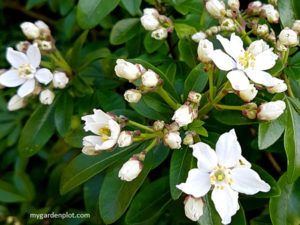
Choisya Mexican Orange Blossom
Choisya ternate, also known as Mexican orange blossom or Mexican mock orange, is a fragrant flowering, evergreen shrub. Tips how to grow and prune.
Deer Problems In The Garden, Deer Proofing Your Yard, And Deer Resistant Plants
We may love deer, but we also don’t want them around eating our plants. In our neck of the woods, nothing draws a more mixed reaction than these wild animals. It all depends on our gardens. Deer are lovely creatures, and the fawns are adorable, but like many gardeners, they can be pests too. They can devour a garden bed in no time, eating foliage, flowers and stems. Many garden centres in the Pacific Northwest will stock a selection of ‘deer resistant’ plants. But what does ‘deer resistant’ plants mean? It does not mean your plant is deer-proof. No, they are not deer proof plants. I have had hungry deer try just about anything, including deer resistant plants. And the young “Bambi” will nibble on plants until it figures out what tastes good. If deer are a constant problem in your garden, invest in growing ‘deer resistant’ plants, and learn how to deer proof your garden naturally is the way to go.
Deer Repellent Spray And Household Deterrents
A deer repellent spray will help keep the deer away and manage this pest problem. Household deterrent ideas that have seen some success include a bar of soap, the strong fragrant deodorant kind. Or use old pantyhose and stuff with human hair or a stinky egg. With their keen sense of smell, they are likely to be repelled from trying your plants. It’s not an attractive garden look. But hey, if you’re at your wits end… Hanging small mirrors or old CDs will also frighten deer away from your garden.
Fence Your Garden
Alternatively, invest in a tall fence. In our area, municipal fence bylaws are limited to a maximum height of 1.9 metres (6.2 ft). This height seems to work for us and is an effective deterrent in our garden. However, deer have been known to be able to jump this height when desperate or curious. Generally, a 2.4 metres (8 ft) fence would ensure deer are kept out of your garden.
Recommended Deer-Resistant Plants and Flowers
The following are the recommended deer-resistant plants and flowers that we have in our garden. But remember that fawns or hungry deer will sample almost all plants. But at least using deer-resistant plants, whether perennials or annuals, will aid in proofing your garden from being eaten down. Don’t forget to lightly spray new plants with deer repellant to deter the initial curiosity from deer – in my garden; they always seem interested in anything new we plant!

Choisya ternate, also known as Mexican orange blossom or Mexican mock orange, is a fragrant flowering, evergreen shrub. Tips how to grow and prune.
Aromatic Russian sage is a summer and autumn flowering perennial. Here are tips for where to plant and how to grow Perovskia atriplicifolia.
Tips for planting and growing dusty miller plant (silver ragwort) in the garden. How to grow and care as a perennial or annual depending on your region.
Guide on how to grow Daboecia cantabrica (Irish heath) showing how easy it is to plant, care and prune this low-growing, evergreen shrub.
Heather and heath guide with details where to plant and how to grow and prune your shrubs. A popular low-growing evergreen flowering plant.
Pieris japonica is a perfect year-round evergreen shrub. This guide provides recommendations, and info where to plant and how to grow Pieris.
Growing Skimmia japonica (Japanese Skimmia) is easy. They are reliable evergreen shrubs. Learn how to care for this shade-loving plant.
Guide on where to plant and how to grow and prune Pittosporum. In particular, how to care for the P. tenuifolium and what is best for a healthy shrub.
Sedums, also known as stonecrop, are hardy perennials. Following guide with tips for growing sedum show how to plant and care for stonecrop.
Growing aster, or Michaelmas Daisy, is easy with this guide. Read how to plant and care for aster and ensure it produces masses of flowers.
Coreopsis, also known as tickseed, is a popular perennial plant for summer gardens. Here is a planting and care guide for growing tickseed.
The Rudbeckia, often called Black-Eyed Susan or Coneflower is a summer and autumn favourite. They are easy to grow with this plant guide.